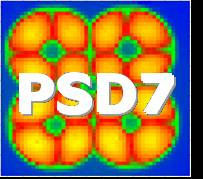Speaker
Dr
Silvia Pani
(University College London)
Description
Although conventional mammography is currently believed to be the
most effective breast screening tool, alternative techniques are
being sought for those cases in which a second-stage examination is
required.
Diffraction Enhanced Breast Imaging (DEBI) is a promising
alternative, as the difference in the diffraction profiles of
healthy breast tissue and of carcinoma is much more significant than
the difference between the X-ray attenuation coefficients of the
two, determining the contrast in conventional mammography [1].
In particular, the maximum differences in signal from the two
tissue types are detected when the momentum transfer (=1/ sin
(/2), where is the beam wavelength and is the scattering angle)
is =1.1 nm-1 or =1.7 nm-1; in the first case the signal from
normal tissue is about twice the signal from carcinoma, while in the
second case the diffracted intensity from carcinoma is about 1.5
times higher than that from healthy tissue. The signal intensities
are comparable at =1.4 nm-1.
Due to the low scattered photons yield, a detector with a very low
noise is needed. A good candidate is a Controlled Drift Detector
(CDD) developed at Politecnico di Milano, featuring a very low noise
level and spectroscopic capabilities [2,3].
This paper presents the preliminary results obtained using a CDD for
the acquisition of diffraction images using monochromatic X-rays.
Materials and Methods
A prototype of CDD with a sensitive area of about 6 mm x 4 mm and a
pixel size of 180 µm was used.
Monochromatic synchrotron radiation beams from the ELETTRA
synchrotron radiation souce were used with an energy of 18 and 26
keV. Both transmission and diffraction images were acquired. For the
latter, a multihole collimator was used and the detector was tilted
at 9°, hence detecting diffracted X-rays with a momentum transfer of
1.1 nm-1 or 1.7 nm-1 when using 18 keV or 26 keV beams, respectively.
Images of test objects and of meat samples were acquired.
Images were reconstructed by integrating either the whole spectrum
detected from each pixel, or only the main peak.
Results and discussion
All diffraction images showed an increase in contrast with respect
to the transmission images acquired at the same energies, thus
proving the suitability of the CDD for DEBI applications.
No significant difference was found in the peak images with respect
to the full-spectrum images; however, the spectroscopic capability
appears a promising characteristic for using the CDD with
conventional X-ray sources.
References
[1] G Kidane et al. Phys Med Biol 1999: 44; 1791-1802.
[2] A Castoldi et al. Nucl Instrum Meth in Phys Res A 2003: 512; 250-
256.
[3] A Castoldi et al. Nucl Instrum Meth in Phys Res A 2004: 518; 426-
428.
Primary author
Dr
Silvia Pani
(University College London)
